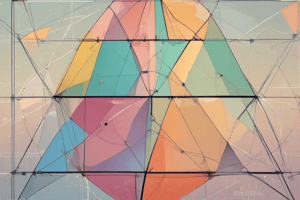Podcast
Questions and Answers
Padanan jenis-jenis berikut dengan deskripsi yang benar:
Padanan jenis-jenis berikut dengan deskripsi yang benar:
Persegi = Semua sudut siku-siku (90°) dan semua sisi sama panjang (kongruen) Jajaran genjang = Sisi sejajar berlawanan sama panjang Belah ketupat = Diagonal saling tegak lurus Trapesium = Memiliki sepasang sisi sejajar
Sesuaikan pernyataan tentang hubungan garis dan titik di kuadran berikut:
Sesuaikan pernyataan tentang hubungan garis dan titik di kuadran berikut:
Garis tegak lurus membagi titik menjadi dua bagian yang sama besar = Midpoint dari sebuah segmen Membuat garis tegak lurus melalui titik tertentu = Menghitung jarak antara titik Garis sejajar dengan jarak yang sama dari satu sama lain = Konstruksi garis tegak lurus melalui titik Garis tegak lurus meneruskan garis lain = Membentuk sudut siku-siku
Hubungkan masing-masing jenis kuadran berikut dengan contohnya:
Hubungkan masing-masing jenis kuadran berikut dengan contohnya:
Persegi = Semua sudut adalah 90° dan semua sisi memiliki panjang sama Jajaran genjang = Dua pasang sisi sejajar dengan panjang yang sama Belah ketupat = Diagonal saling tegak lurus Trapesium = Memiliki satu pasang sisi sejajar
Sesuaikan masing-masing properti kuadran berikut dengan keterangannya:
Sesuaikan masing-masing properti kuadran berikut dengan keterangannya:
Hubungkan jenis-jenis segi empat berikut dengan deskripsinya:
Hubungkan jenis-jenis segi empat berikut dengan deskripsinya:
Sistem persamaan linear terdiri dari apa?
Sistem persamaan linear terdiri dari apa?
Aplikasi apa dari aljabar linear dalam keuangan?
Aplikasi apa dari aljabar linear dalam keuangan?
Bagaimana cara menentukan solusi unik pada sistem persamaan linear?
Bagaimana cara menentukan solusi unik pada sistem persamaan linear?
Manfaatkan konsep aljabar linear dalam pembelajaran mesin, apakah itu?
Manfaatkan konsep aljabar linear dalam pembelajaran mesin, apakah itu?
Flashcards are hidden until you start studying
Study Notes
Quadrilateral Geometry and Linear Algebra Equations
Geometry and algebra intersect in various ways when it comes to understanding and working with shapes and mathematical expressions. This intersection is particularly evident in the study of quadrilateral geometry and linear algebra equations. In this article, we will explore how these two branches of mathematics interact.
Quadrilateral Geometry
A quadrilateral is any polygon with four sides and four vertices. Common examples of quadrilaterals include squares, rectangles, parallelograms, trapezoids, and rhombuses. These shapes have unique properties and can be described using various geometric measurements like side lengths, angles, diagonals, area, and perimeter.
Properties of Quadrilaterals
- All interior angles sum up to 360°.
- For squares, all inner angles measure 90°, and opposite sides are equal (symmetric).
- Right triangles form a part of the larger right triangle in a rectangle.
- Perpendicular lines bisect each other (divide into two congruent parts).
- Parallel lines are equidistant from each other.
These properties allow us to make numerous calculations, such as finding the midpoint of a segment, constructing perpendicular lines through points, calculating distances between points, etc..
Types of Quadrilaterals
- Squares - Regular quadrilaterals where all angles are right (90°) and all sides are equal (congruent).
- Rectangles - Quadrilaterals where all angles measure 90°, but sides have different lengths.
- Parallelograms - Quadrilaterals with opposite sides parallel and equal in length.
- Trapezoids - Quadrilaterals with one pair of parallel sides and unequal lengths.
- Rhombuses - Regular quadrilaterals where all sides have equal length and opposite angles are equal.
Linear Algebra Equations
Linear algebra is a branch of mathematics that deals with linear equations, i.e., equations in which the highest power of the unknown is 1. It involves the study of vectors, vector spaces, linear transformations, and systems of linear equations.
Linear Equations
Linear equations are equations that can be written in the form:
ax + b = 0
where a and b are constants, and x is the variable. For example, the equation 2x + 5 = 0 is a linear equation, as the highest power of x is 1.
Systems of Linear Equations
A system of linear equations is a set of linear equations that have the same variables. Solving such systems involves finding the values of the variables that satisfy all the equations simultaneously. For example, the system of equations:
2x + 5 = 0 x + 1 = 0
has the unique solution x = -2.5.
Applications of Linear Algebra
Linear algebra has numerous applications in various fields, including:
- Computer graphics - 3D models are represented using matrices and vectors.
- Finance - Linear algebra techniques are used for portfolio optimization and risk assessment.
- Cryptography - Linear algebra concepts are fundamental to many encryption methods.
- Machine learning - Vector spaces and linear transformations are used in algorithms like PCA (Principal Component Analysis).
Solving Systems of Linear Equations Using Quadrilaterals
In real life, we often encounter systems of linear equations when solving problems involving quadrilaterals. For example, given two triangles that share a side with different angles (acute, right, or obtuse), we can determine which triangle is larger if we find their geometric means and compare them. This involves using linear algebra techniques to solve systems of linear equations related to the lengths of the sides in each triangle.
Conclusion
The intersection between geometry and algebra allows us to analyze and understand various mathematical concepts more deeply. By examining the properties of quadrilaterals through geometrical perspectives and considering their applications in linear algebra, we gain a comprehensive understanding of these mathematical structures.
Studying That Suits You
Use AI to generate personalized quizzes and flashcards to suit your learning preferences.




